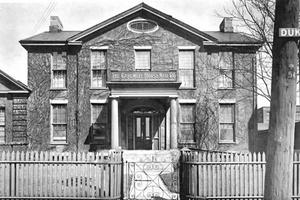This content is from a series created in partnership with Museum Services of the City of Toronto and Heritage Toronto. We gratefully acknowledge funding from the Ontario Ministry of Tourism, Culture and Sport, and the Department of Canadian Heritage.
Toronto Feature: Campbell House
"Saving Old House Inspires Preservation"
When the Queen Mother officially opened Campbell House in its new University Avenue location, Torontonians saw a treasure from their past restored. In a city that had been demolishing many of its finest old buildings, this demonstration of reverence for a distinguished work of 19th-century architecture and a piece of Toronto history showed a change in public opinion in favour of heritage preservation.The Campbell House was built by Sir William Campbell, Chief Justice of Upper Canada, and his wife Hannah in 1822. The stately Georgian house originally stood at what is now the intersection of Adelaide and Frederick streets. After serving as a private residence for most of the 19th century, it was turned into a business office and even a factory for horseshoe nails as its neighbourhood transformed into a commercial and industrial area. In 1972, its owners, the Coutts-Hallmark Greeting Cards Company, wanted to use its location for a parking lot. They offered the building to anyone who would move it.
Given the home's association with a former Chief Justice, an association of trial lawyers (The Advocates' Society) raised the funds to move the Campbell House to its present location. The move was a spectacular public event. Streets were shut down and crowds gawked as the 270-tonne structure crept the 1617 metres to its new foundation.
Today the Campbell House is a museum and art gallery, as well as a club for members of the Advocates Society. Most importantly, its move inspired those who shared a love for architectural integrity and a sense of history to unite in preserving remnants of Old Toronto.
See Also Heritage Conservation; Architectural History 1759-1867.

 Partager sur Facebook
Partager sur Facebook Partager sur X
Partager sur X Partager par Email
Partager par Email Partager sur Google Classroom
Partager sur Google Classroom





